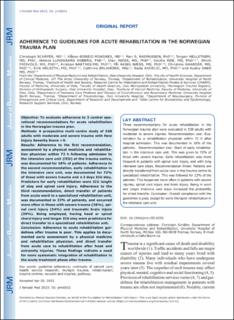| dc.contributor.author | Schäfer, Christoph | |
| dc.contributor.author | Moksnes, Håkon Øgreid | |
| dc.contributor.author | Rasmussen, Mari Storli | |
| dc.contributor.author | Hellstrøm, Torgeir | |
| dc.contributor.author | Søberg, Helene L. | |
| dc.contributor.author | Røise, Olav | |
| dc.contributor.author | Røe, Cecilie | |
| dc.contributor.author | K Frisvold, Shirin | |
| dc.contributor.author | Bartnes, Kristian | |
| dc.contributor.author | Næss, Pål Aksel | |
| dc.contributor.author | Gaarder, Aslaug Christine | |
| dc.contributor.author | Helseth, Eirik | |
| dc.contributor.author | Brunborg, Cathrine | |
| dc.contributor.author | Andelic, Nada | |
| dc.contributor.author | Anke, Audny Gabriele Wagner | |
| dc.date.accessioned | 2023-11-14T07:07:34Z | |
| dc.date.available | 2023-11-14T07:07:34Z | |
| dc.date.created | 2023-11-05T13:37:33Z | |
| dc.date.issued | 2023 | |
| dc.identifier.issn | 1650-1977 | |
| dc.identifier.uri | https://hdl.handle.net/11250/3102279 | |
| dc.description.abstract | Objective: To evaluate adherence to 3 central ope-
rational recommendations for acute rehabilitation
in the Norwegian trauma plan.
Methods: A prospective multi-centre study of 538
adults with moderate and severe trauma with New
Injury Severity Score > 9.
Results: Adherence to the first recommendation,
assessment by a physical medicine and rehabilita-
tion physician within 72 h following admission to
the intensive care unit (ICU) at the trauma centre,
was documented for 18% of patients. Adherence to
the second recommendation, early rehabilitation in
the intensive care unit, was documented for 72%
of those with severe trauma and ≥ 2 days ICU stay.
Predictors for early rehabilitation were ICU length
of stay and spinal cord injury. Adherence to the
third recommendation, direct transfer of patients
from acute ward to a specialized rehabilitation unit,
was documented in 22% of patients, and occurred
more often in those with severe trauma (26%), spi-
nal cord injury (54%) and traumatic brain injury
(39%). Being employed, having head or spinal
chord injury and longer ICU stay were predictors for
direct transfer to a specialized rehabilitation unit.
Conclusion: Adherence to acute rehabilitation gui-
delines after trauma is poor. This applies to docu-
mented early assessment by a physical medicine
and rehabilitation physician, and direct transfer
from acute care to rehabilitation after head and
extremity injuries. These findings indicate a need
for more systematic integration of rehabilitation in
the acute treatment phase after trauma. | en_US |
| dc.language.iso | eng | en_US |
| dc.rights | Navngivelse-Ikkekommersiell 4.0 Internasjonal | * |
| dc.rights.uri | http://creativecommons.org/licenses/by-nc/4.0/deed.no | * |
| dc.title | Adherence to Guidelines for Acute Rehabilitation in the Norwegian Trauma Plan. | en_US |
| dc.type | Peer reviewed | en_US |
| dc.type | Journal article | en_US |
| dc.description.version | publishedVersion | en_US |
| cristin.ispublished | true | |
| cristin.fulltext | original | |
| cristin.qualitycode | 1 | |
| dc.identifier.doi | 10.2340/jrm.v55.6552 | |
| dc.identifier.cristin | 2192248 | |
| dc.source.journal | Journal of Rehabilitation Medicine | en_US |

